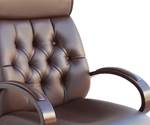Video: HP on Additive Manufacturing for Production
HP’s Timothy Weber discusses VW’s plans for making metal parts via AM and the way forward to implementing additive as a production process.
Last year, HP introduced its Metal Jet system for metal part production via additive manufacturing (AM). I recently spoke with Timothy Weber, Ph.D., HP’s global head of 3D metals, about automaker Volkswagen’s plans for part production using this system.
Transcript
Peter Zelinski, Additive Manufacturing
HP’s Metal Jet is a metal 3D printing system for production. Volkswagen is an early user. HP’s Tim Weber recently spoke to me about what it takes to realize the promise of additive manufacturing for production.
Timothy Weber, HP
We started working with VW. They're a great partner because they're trying to figure out, you know, where is the world going when it comes to manufacturing? One of the things they're looking at is how do you start to consolidate parts? They showed a recent part which is previously 16 parts that you can consolidate into one. It was huge weight savings, like 50 percent of the weight basically comes out. If you can compete on economics, now you start taking rivets, welds and other things out and simplify the process. You simplify the yield.
Peter Zelinski
VW has intentions to use this for production, for an electric vehicle, for a newer model car. It seems to me that a challenge of additive manufacturing in production is that a major manufacturer like VW is already invested in conventional production processes for its established products. Additive is finding its way in because there's a new product. It's a chance to take a clean sheet and it's a chance to try to find advantages of an entirely new way to produce. I wonder if you agree that the way in for additive production is going to be new products and fresh starts with new products coming to market.
Timothy Weber
If you have big capital investments like they have for building, say, internal combustion engines, replacing that is a pretty tall bar, right? Even if it's maybe more cost effective. If you start over with a clean sheet of paper off to production, that clearly represents an opportunity. If you look at how most of the equipment is put together, there are a lot of different parts providers. If you find a way to take what was previously eight cheap metal parts and replace it with one 3D-printed part, you have a new supply chain. I see evolutionary improvements to how things are assembled today.
One of the things that we've found is that because there are opportunities to do things differently, like consolidating parts, it almost always requires a top-down mandate where the management structure, the chief of engineering, the CEO, the chief production officer says, “I want an exercise to actually go through the parts with this set of design guidelines and look for where there are opportunities to improve and drive economics to a better point.” If I've been doing this for 20 years—building a certain part a certain way—I'm probably going to continue to do that unless my boss says, “No, I want you to go through this exercise. Here's the new set of design rules. Figure out what you can do.” That's how we've seen a lot of acceleration, at least within HP, for how we drive that.
Peter Zelinski
It sounds like organizationally you're saying that culture has to be the first step. There has to be top-down adoption of additive because it is so transformational that a deliberate culture shift is necessary for it to find its opportunities.
Timothy Weber
That's exactly what I'm saying.
Related Content
Machine Tool Drawbar Made With Additive Manufacturing Saves DMG MORI 90% Lead Time and 67% CO2 Emission
A new production process for the multimetal drawbar replaces an outsourced plating step with directed energy deposition, performing this DED along with roughing, finishing and grinding on a single machine.
Read MoreAdditive Manufacturing Is Subtractive, Too: How CNC Machining Integrates With AM (Includes Video)
For Keselowski Advanced Manufacturing, succeeding with laser powder bed fusion as a production process means developing a machine shop that is responsive to, and moves at the pacing of, metal 3D printing.
Read More3D Printing with Plastic Pellets – What You Need to Know
A few 3D printers today are capable of working directly with resin pellets for feedstock. That brings extreme flexibility in material options, but also requires greater knowledge of how to best process any given resin. Here’s how FGF machine maker JuggerBot 3D addresses both the printing technology and the process know-how.
Read MoreWhat Is Neighborhood 91?
With its first building completely occupied, the N91 campus is on its way to becoming an end-to-end ecosystem for production additive manufacturing. Updates from the Pittsburgh initiative.
Read MoreRead Next
What Your CEO Needs to Know About Additive Manufacturing
Additive manufacturing promises to affect far more than manufacturing alone. When evaluating AM, the perspective needed is the view that sees the impacts all across the enterprise.
Read More3D Printed Polymer EOAT Increases Safety of Cobots
Contract manufacturer Anubis 3D applies polymer 3D printing processes to manufacture cobot tooling that is lightweight, smooth and safer for human interaction.
Read MoreProfilometry-Based Indentation Plastometry (PIP) as an Alternative to Standard Tensile Testing
UK-based Plastometrex offers a benchtop testing device utilizing PIP to quickly and easily analyze the yield strength, tensile strength and uniform elongation of samples and even printed parts. The solution is particularly useful for additive manufacturing.
Read More


















